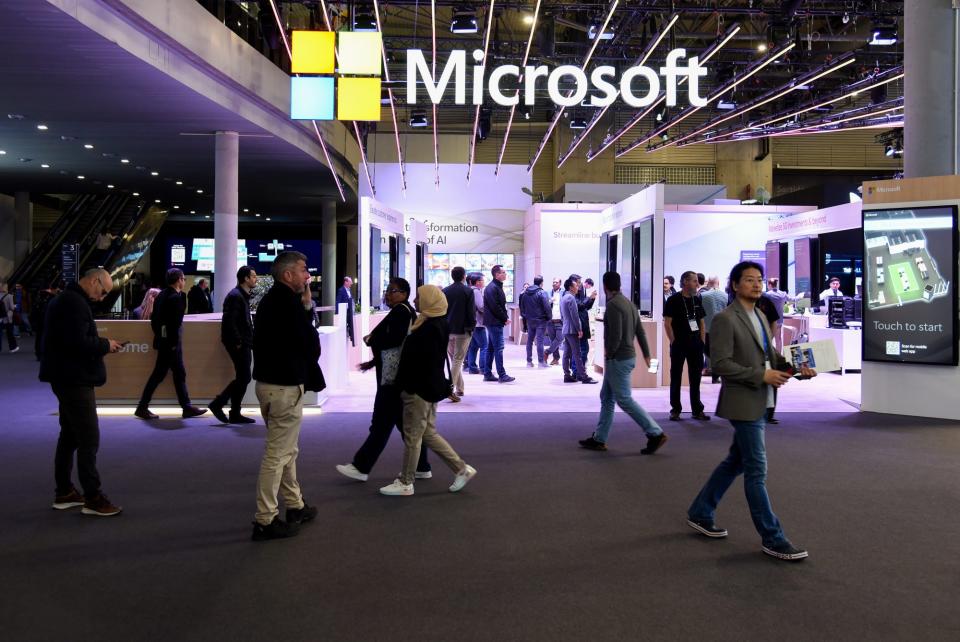Huawei, ZTE showcase AI prowess to telcos at MWC Barcelona as industry gears up for transformation
The telecommunications industry is rushing to explore the potential of generative artificial intelligence (AI), and Chinese equipment suppliers Huawei Technologies and ZTE have joined the pack with their own industry-specific models shown at MWC Barcelona this week.
At the event, the world's biggest trade show for the mobile industry, Huawei launched its self-developed AI model specifically for the telecoms industry.
Dubbed the Huawei Telecom Foundation Model, it enables telcos to provide more intelligent business solutions to consumers and enterprises, and supports carriers in more efficiently using their network resources, Philip Song Xiaodi, chief marketing officer of Huawei's carrier business group, said at a media briefing at the event on Tuesday.
Do you have questions about the biggest topics and trends from around the world? Get the answers with SCMP Knowledge, our new platform of curated content with explainers, FAQs, analyses and infographics brought to you by our award-winning team.
It can also help telecoms firms improve operations and maintenance efficiency, for example, by shortening the time needed to fix a problem in the network after receiving a customer complaint, Song said.
Huawei has no clear timeline for the commercialisation of the telecoms AI model. "We have this kind of capability, and we have to work with our partners to explore it. I think it's still a long way [to commercialisation]," Song added.
The model was built on Huawei's self-trained Pangu AI model, which was released as version 3.0 last year, focusing on industrial uses in sectors including coal mining, finance and government.
AI was centre stage at this year's MWC Barcelona, with signage featuring "AI" and "intelligence" filling the venue, and plenty of product demonstrations and promises made by exhibitors from telcos to smartphone makers.
Separately, Huawei's Chinese rival ZTE showcased its Nebula Telecom Model, highlighting a use case to support communication services at the Hangzhou 2022 Asia Games, including live-streams on platforms such as Douyin, the Chinese sister app of TikTok.
Nebula helped reduce 80 per cent of the workload for operations and maintenance while improving efficiency, according to ZTE.
"We handled traffic for over 1.5 million people during the 16-day event and received no complaints or failures," said Gao Zhengguang, a ZTE research manager.
Global telcos have already started their generative AI projects in hopes of improving business and opening up new revenue streams. China's three major operators - China Mobile, China Unicom and China Telecom - all launched their own self-trained large language models in 2023.
"Only companies and organisations of larger scale have the budget to deploy 5G technologies offered by telecoms operators, and it's challenging for the operators to expand their enterprise clientele," said Ethan Qi, associate director at Counterpoint Research.
"With AI capabilities, telecoms operators can open up more commercialisation opportunities by offering their existing enterprise clients new services enabled by AI," Qi said.
Industry players in the west are also forming partnerships to further explore the potential of AI. On Monday, US chip maker Nvidia joined tech giant Microsoft and telecoms gear vendors Ericsson and Nokia to form the AI-RAN Alliance, to explore the integration of AI in radio access network (RAN) technology and mobile networks.
Other founding members of the alliance include UK-based chip designer Arm, US cloud service provider Amazon Web Services, South Korean tech giant Samsung Electronics, and US telecoms operator T-Mobile USA, among others, with the omission of Chinese members.
During MWC, Nvidia also announced a broadening of its partnership with US software firm ServiceNow, to introduce generative AI solutions targeting telcos.
The partnerships come amid intensified restrictions imposed by the US government to curb the development of China's AI industry. US trade sanctions prevent Nvidia from exporting to China its advanced GPUs, such as the A100 and H100, which are sought-after for training AI systems.

A view of the Microsoft booth at the Mobile World Congress (MWC), February 29, 2024. Photo: SOPA Images via ZUMA Press Wire/dpa alt=A view of the Microsoft booth at the Mobile World Congress (MWC), February 29, 2024. Photo: SOPA Images via ZUMA Press Wire/dpa>
Nvidia's tailor-made A800 and H800 GPUs, developed as workarounds for Chinese clients, were subsequently blocked by updated US controls last October, resulting in new alternatives such as the H20 that compete with AI chips developed by Huawei, which is also under US trade sanctions.
Nvidia identified Huawei as a competitor in certain categories of AI chips for the first time in a recent filing with the Securities and Exchange Commission.
For Huawei's own telecoms AI model, the company is collaborating with global partners in Europe and the Middle East, according to Huawei's Song.
Huawei's president of ICT products and solutions Yang Chaobin, called for collaboration among industry partners to promote the adoption of AI in the telecoms industry during the launch of the firm's industry-specific model.
This article originally appeared in the South China Morning Post (SCMP), the most authoritative voice reporting on China and Asia for more than a century. For more SCMP stories, please explore the SCMP app or visit the SCMP's Facebook and Twitter pages. Copyright © 2024 South China Morning Post Publishers Ltd. All rights reserved.
Copyright (c) 2024. South China Morning Post Publishers Ltd. All rights reserved.

 Yahoo Finance
Yahoo Finance 